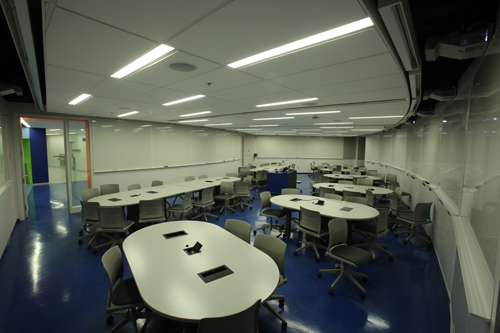
Not even a five-week construction strike could stop the transformation of empty storage into high-tech hub
By James Martin
When TLS Educational Developer Adam Finkelstein heard about Alvin Shrier’s plans to visit his daughter, a McGill student on a six-month exchange Down Under, he offered the physiology professor an unusual sightseeing tip: see if the University of Melbourne has any ideas about what to do with empty space on the second floor of the McIntyre Medical Building.
Shrier is the Faculty of Medicine representative on the Teaching and Learning Services Working Group, which each year decides how to allocate approximately $1-million earmarked for upgrading educational facilities. He arranged a meeting with Peter Jamieson, a University of Melbourne professor who has led workshops on the future of learning spaces through the Universitas 21 international network of universities. Jamieson toured Shrier through spaces that have been designed “to experiment with different modular ways of interactive teaching,” allowing for quick conversion from lecture hall to intimate clusters perfect for small-group problem-solving.
“I was just blown away,” says Shrier. Blown away, that is, and full of ideas to share with the team that was figuring out what to do with the storage space that McGill Libraries had recently freed up beneath the Osler Library of the History of Medicine and the Life Sciences Library service point. That was three years ago.
Dubbed CyberMed, the newly opened space is unrecognizable from its former incarnation. CyberMed consists of four areas: three Active Learning Classrooms, which can each fit 80 people in various seating configurations, seven 16-person seminar rooms, informal study space and rooms for the MedIT support group area. CyberMed is primarily used by students and lecturers in Nursing, Medicine, Physical and Occupational Therapy and Biology, but can be reserved by anyone in the university through the central booking system.
“Students have been telling us what they need and CyberMed is about meeting those needs,” says Diane Koen, Senior Director, Planning and Resources, McGill Library. “We’ve been hearing from students that they need more places to study. They need more group study rooms. And instructors and students alike want classrooms that support interaction.”
CyberMed’s Active Learning Classrooms are the seventh, eighth and ninth of their kind on campus. (Read more about ALCs at McGill here.) What sets these rooms apart from traditional classrooms, says TLS’s Adam Finkelstein, is ground-up design geared toward “enhancing active and collaborative learning and student-faculty interaction. When you walk into a traditional lecture hall, the layout gives you a sense of how you are to behave and interact: the instructor is expected to talk and the students are expected to take notes. The active learning classrooms flip that around to help support the deep learning that comes from students and faculty working on higher level problems together.”
Donald Nycklass, Senior Project Manager in the Facilities Operations and Development division of University Services, was part of the team that pushed to make sure CyberMed was ready for its September debut—despite major setbacks such as a five-week construction strike during the summer. He points out that, although there are similar spaces in other buildings, CyberMed represents the next generation in Active Learning Classrooms. “We used all-new technologies this time,” he says. “Each room has 16 projectors, which are hard-wired to every table so that students can share their work and ideas on any or all of eight porcelain white boards that do double-duty as both projection and writing surfaces. For the first time at McGill, that’s all high-definition.”
There’s more to come, too, with new projects underway in the Trottier and Arts buildings. However, clarifies Finkelstein, there are limits to this teaching makeover. “It’s not about replacing every single lecture hall on campus,” he says. “It’s more about rebalancing the types of spaces so there are places that support different kinds of learning.”
Alvin Shrier points another thing McGill probably won’t be doing. “At the University of Melbourne I saw a really neat year-round outdoor interactive learning space, complete with a barbeque,” he recalls. “But Melbourne’s a lot more amenable to that than Montreal.”
CyberMed was funded by approximately $400,000 from the Ministère de l’éducation du Québec, with additional funds coming from the Teaching and Learning Space Working Group classroom funding, Deferred Maintenance central funding, the McGill Library and the Faculty of Medicine.
